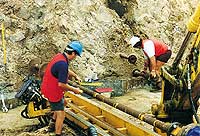Tools & Resources
Screw Piles Anchor Terrigal Sea Wall
A sea wall at Terrigal, on the New South Wales central coast, features the use of steel screw anchors to secure the wall against the ocean's worst incursions.
Replacing a 1970s timber structure, the new wall is mostly hidden. Only a metre or so is visible of a structure more than 10 metres deep. Beneath the sandstone-look capping is a vertical wall of sheet steel, anchored back to the land by over 230 Piletech steel screw anchors.
Terrigal's new wall runs for over 400 metres, of which 380 metres is protected by the underground structure. Built by Melbourne-based contractor Austral Constructions, it is the first sea wall project to incorporate Piletech's ground anchoring technology.
The project began with excavation of a trench along the length of the wall, with the sand backed up in a temporary bund wall to keep out the sea. Vertical steel sheet piles were driven in nine metres deep, with 10-metre screw anchors driven in above the top of the piles at angles of five to 13 degrees from horizontal. These two elements were then tied together by a one metre square reinforced concrete beam cast atop the piles. Square plates were attached to the anchor ends to secure them in the concrete.
On top of the concrete beam is a two-metre wall of sandstone-look blocks, of which about half remained visible after the trench was refilled. The wall should protect the waterfront from all but the worst assaults of the ocean, but the screw anchors will save the wall itself if the ocean scours excessive sand from the beach.
Piletech used heavy-wall pipe for the Terrigal anchors, with a diameter of 88.9 mm and wall thickness of 9.5 mm. Piletech conducted 10 physical pull-out tension load tests in the Terrigal sand to confirm its engineering calculations. Test results determined torque requirements during installation.


